
Is dandelion a friend or foe? A thing of beauty or a yard-blanketing beast?
Well, it all depends on how you choose to look at it.
If you consider it an obnoxious weed that dots your garden with horrific spots of yellow, then you are probably among the majority who favor conventional short-green-grass lawns. The shorter the cut and the less wild, the better.
However, when you take into consideration that dandelions are undoubtedly nutritious from root to flowering tip, then dandelions in your unsprayed lawn will always be your friends.
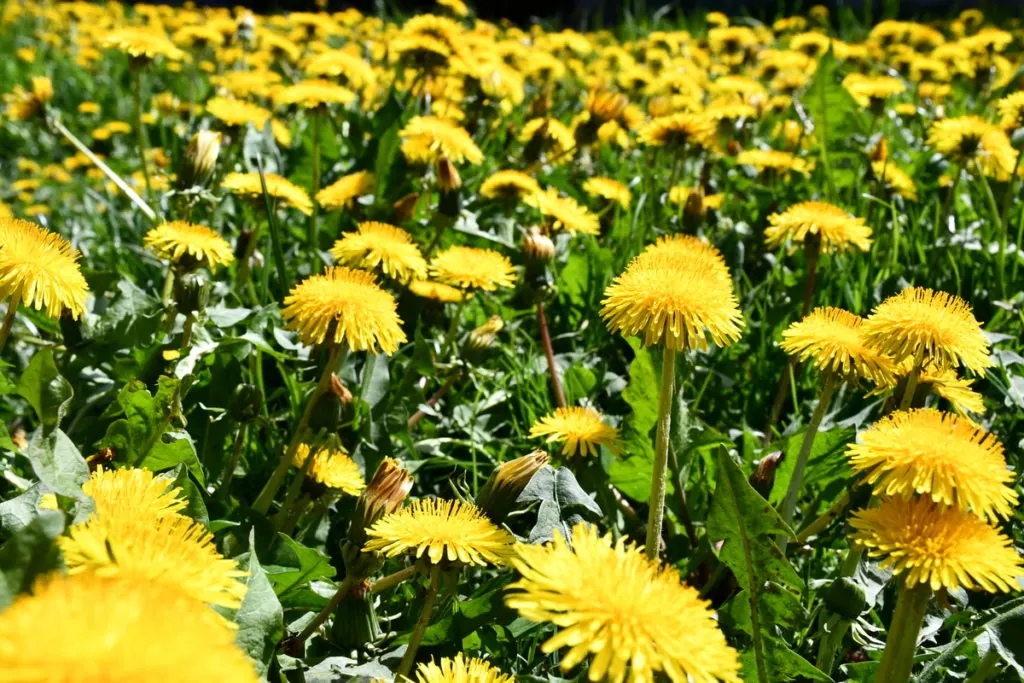
If you’d like to encourage even more dandelions (and a plethora of wildflowers in general) go ahead and delay mowing, or scything, until June.
Your neighbors may think you are a little bit crazy, for rewilding your backyard, but you know better than that.
Rewilding our garden, and our life, is one of the greatest steps we can take to get more nature + vitamin D in our system. We aren’t meant to sit around all day watching the screen, we are supposed to be out doing, creating and making. This brings about a meaningful and intentional life.
Let’s get on with the details, so you can head out to a safe place to pick your own fresh dandelion blossoms. In two weeks’ time, a dandelion infused oil will be yours for the healing.
Dandelions aren’t just for the bees
It is worth mentioning, because it always comes up, that dandelions are not in fact the first food for bees. Bees collect pollen and nectar from a variety of sources:
- chickweed
- henbit
- purple dead nettle
- ground ivy
- tree blossoms, particularly of willow, maple and fruit trees
All of the above are higher quality sources of nutrition than the humble dandelion. Which, by the way, lacks the vital amino acids that bees need.
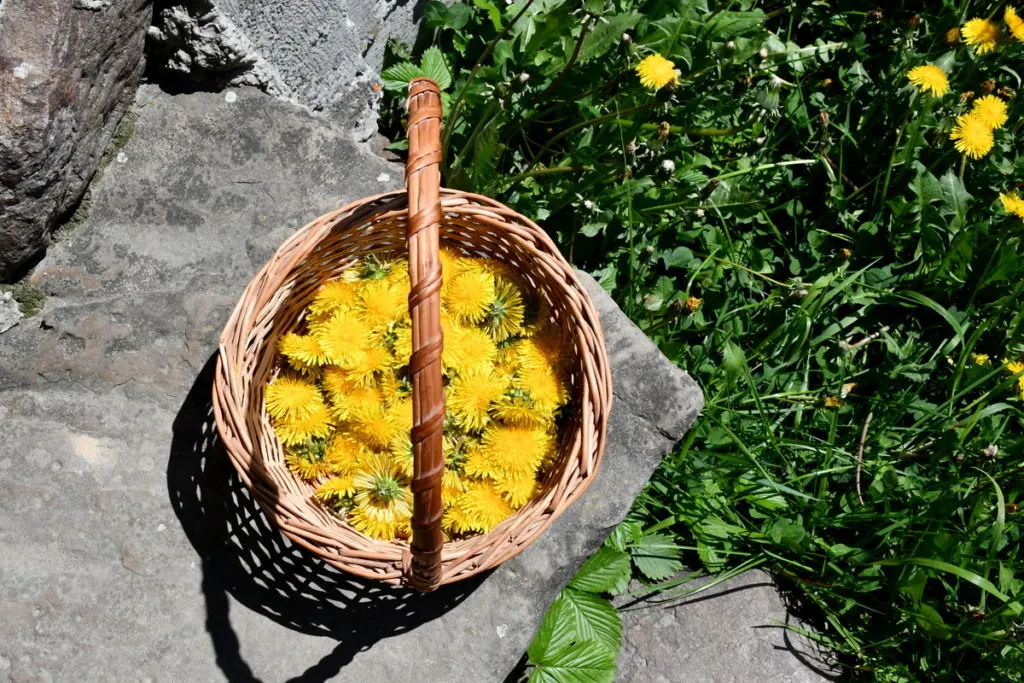
If you want to read more, Tracey’s article explains in further detail: Actually, You Don’t Need to Save the Dandelions for The Bees.
Go ahead and buzz this information about the internet, or share with your family and friends if you will, so that we can all get on with taking just as many dandelions as we need.
When it is all said and done, you don’t need very much. For every handful of dandelion flowers you need to create an infused oil, there are hundreds of thousands more out there. There is absolutely no way you could ever count them all.
Related reading: 16 Exciting Things To Do With Dandelion Flowers
Why use dandelion oil?
Aside from harvesting dandelion roots for coffee and tea, the leaves for fresh eating and dried, the flowers are a little harder to preserve.
Infused oils with petals are incredibly easy to make. But, other than that, they should have a meaningful purpose and a place in your herbal medicine cabinet.
Which may lead you to ask, what can I use dandelion-infused oil for?
Homemade dandelion oil is wonderful for soothing those garden-related aches and pains in your muscles and joints.
It soothes dry skin, it can be added to herbal bath bombs, to healing dandelion balms and more.
Dandelion oil is a fantastic and healing gift from nature. Add a little essence of lavender and a much needed stress relief is instantly available at your fingertips.
DIY dandelion infused oil ingredients
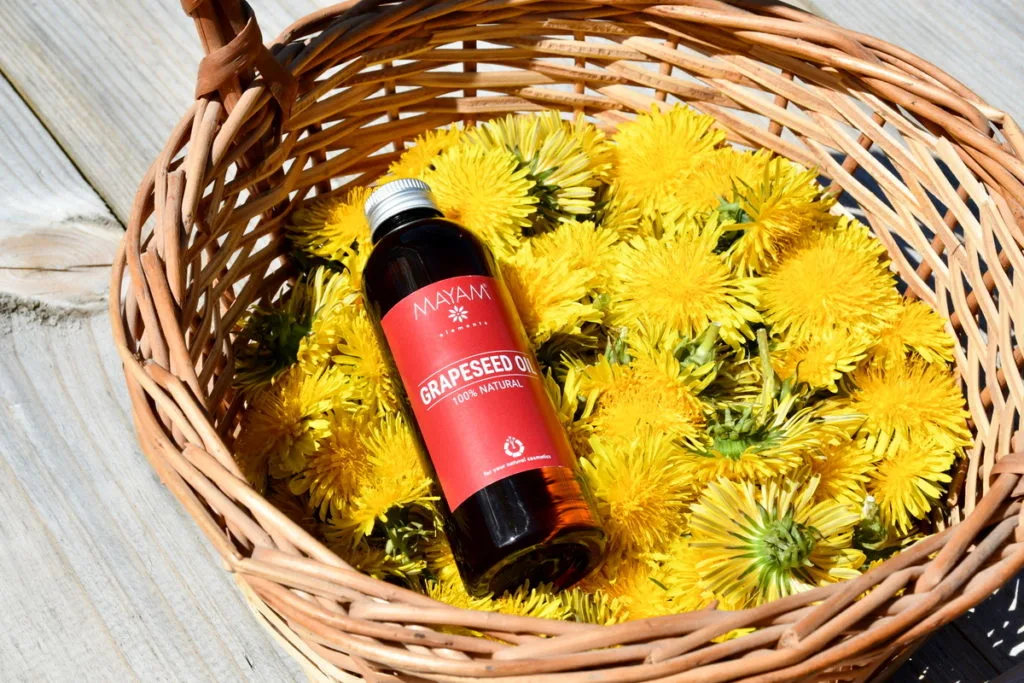
Let’s make this really simple.
Here is all you need to make dandelion infused oil:
- dandelion flowers (enough to fill a small jar)
- carrier oil (olive oil, grapeseed oil or almond oil for external use, organic if possible)
- a reused glass jar
- breathable lid (cheesecloth or lightly woven cloth) with rubber band
- cheesecloth for straining
You’ll likely have all of these “tools” to get started, so, there is not too much to think about.
When dandelions start to bloom, go out and grab a bunch! While you are at it, don’t forget to harvest some dandelion greens for lunch.
Instructions for making dandelion infused oil
If you don’t have your own private patch of dandelion flowers, ask permission before harvesting. At the same time you can find out whether they have been sprayed or not.
Only forage and harvest herbs, wild greens, flowers, etc. that have not been sprayed. I know, it’s common sense. But, when it comes to dandelions you have to be careful.
Harvesting dandelions
Gather your fully open dandelions on a sunny day, after all the dew has disappeared.
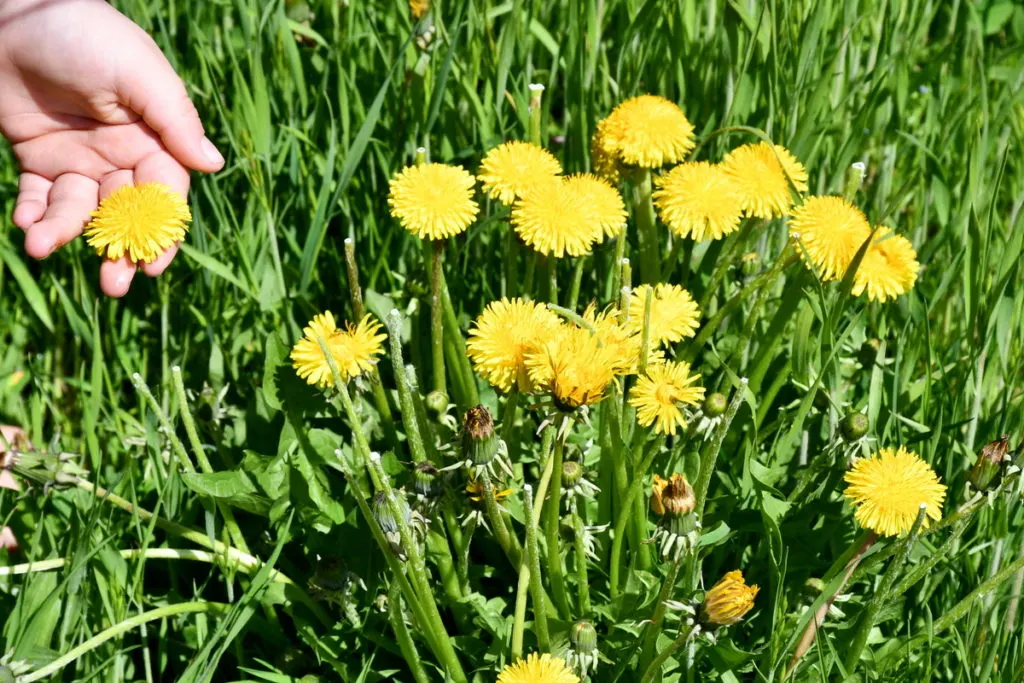
Just pop the dandelion heads off one-by one and there isn’t even any need for scissors. Another way to look at it, is that the white, sticky sap can make your scissors stick together – another reason to use your hands and wash them afterwards. A simple tip that saves clean-up time.
It goes without saying: take only as much as you need.
As in, how much infused oil do you want to make, knowing that it will only last one year? How fast will you use it up? Is one jar enough, or two?
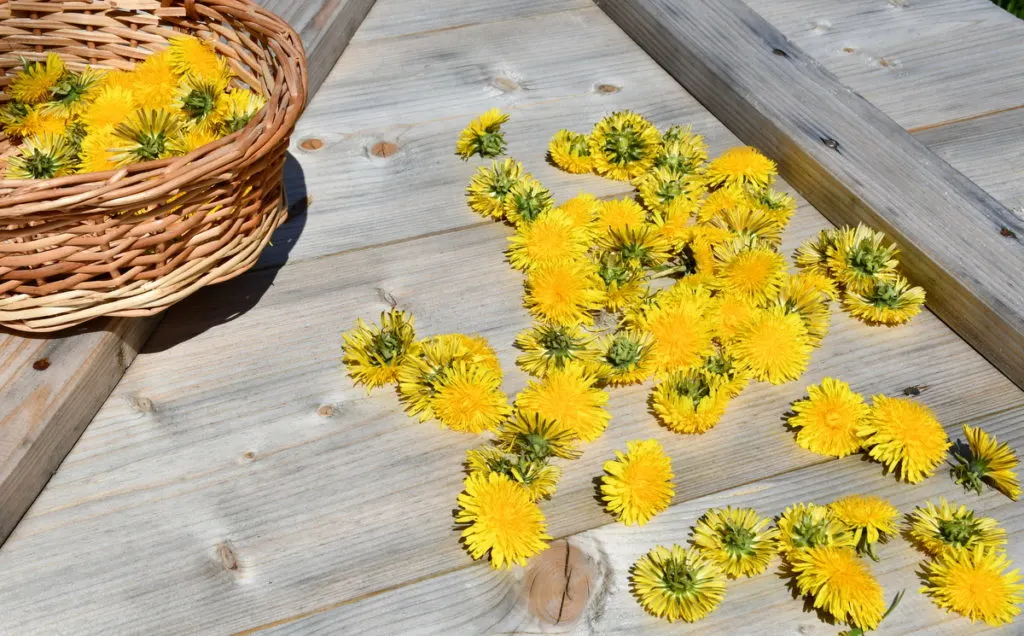
It may also depend on how much oil you have on hand. For instance, grapeseed oil tends to come in smaller bottles. 3.4 oz (100 ml) is all we need for a family of three, considering that our natural remedy and herbal medicine cabinet is quite vast with everything from locally harvested clay to powdered yarrow.
A good measurement to shoot for is your jar being half full with fresh, pre-wilted blossoms.
Wilt the dandelions
Some sources say to wash the dandelions first. Then wilt them overnight.
The reason being that dandelions are often stepped on, which may make them dirty.
If, however, you are harvesting from a wild meadow, or gently used backyard, there will be plenty of areas where the dandelions are not trampled.
Wilt your dandelion blossoms for at least 8 hours, not more than 24.
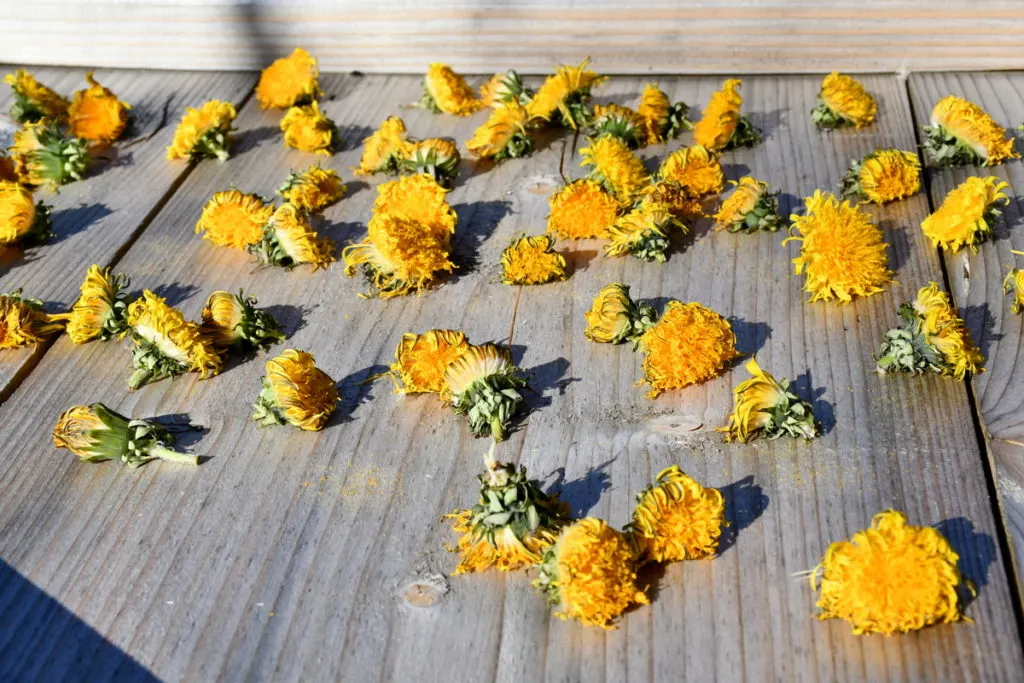
It is always best to harvest where no house pets are wandering about.
Since infused oils can get moldy if too much moisture is present, it is best to wilt the flowers before adding your oil of choice.
Rather than washing the blossoms, it is perfectly okay to let the dandelion flowers sit out in the sun for an entire afternoon. In this time, any insects have a chance to crawl or fly away.
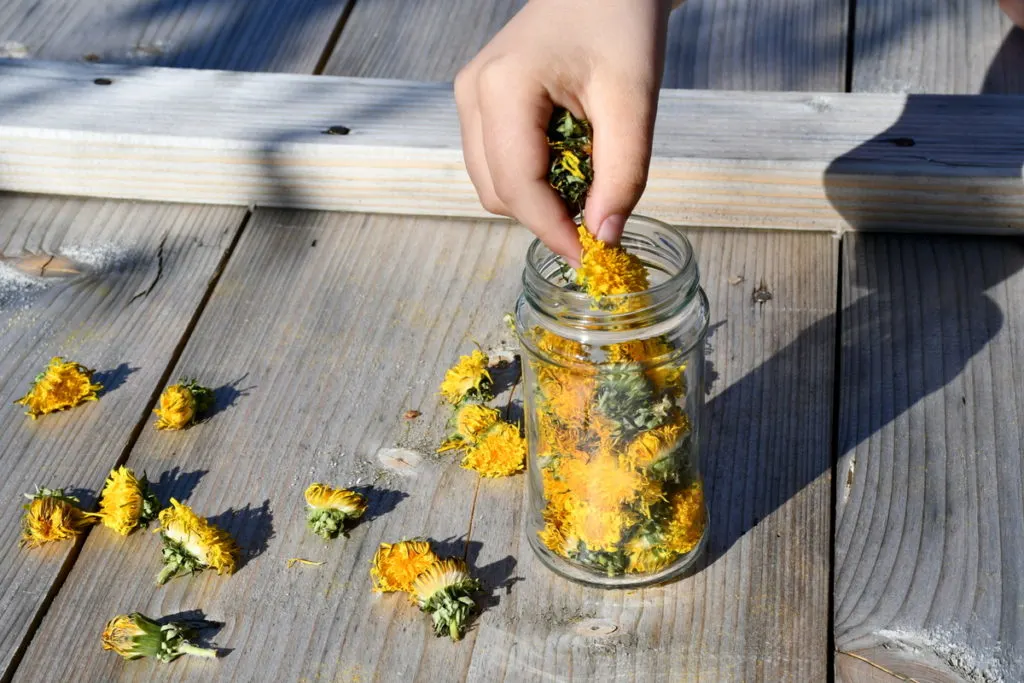
As for drying dandelions, that is a more difficult task, as they tend to go to seed in the meantime.
Making the dandelion oil
The next step is to pour your carrier oil of choice over the wilted dandelions. Add enough to completely cover the blossoms.
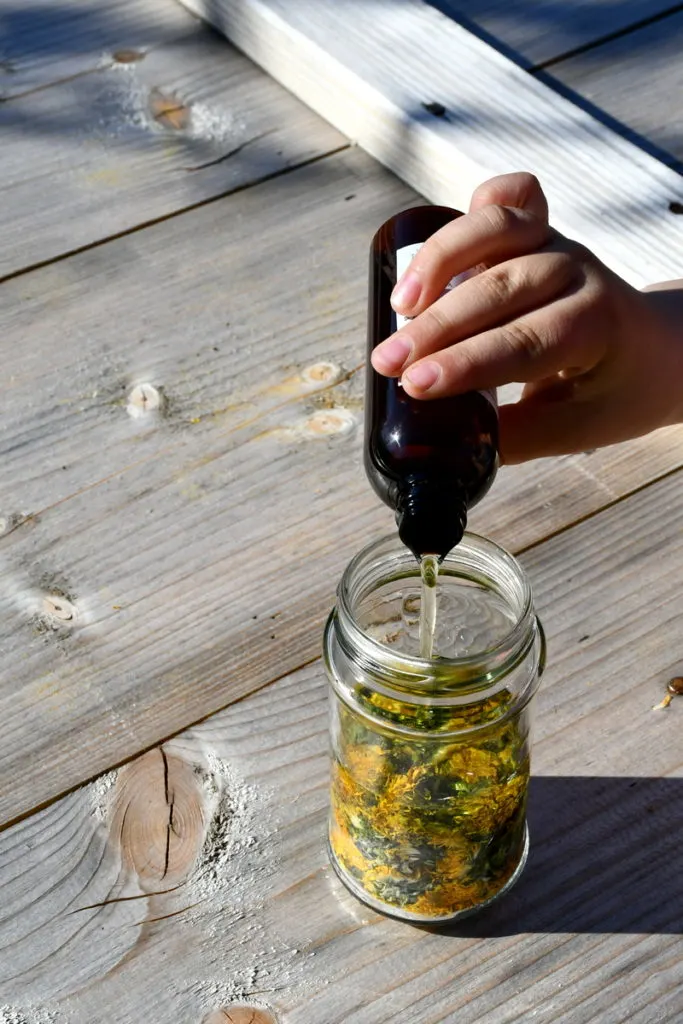
Gently stir with a knife, or chopstick, to make sure there are no air pockets.
Cover with cheesecloth and a rubber band, or put the lid on loosely. Use whatever is available at the time. We aren’t talking about specifics here, simply because there aren’t any.
Use your intuition and common sense – all will be fine. Just be sure to shake or stir your oil mixture every couple of days.
Steep the dandelion blossoms for 2 weeks, not more.
Because the flowers have so much moisture in them, letting them sit for any longer than recommended, can result in moldy conditions.
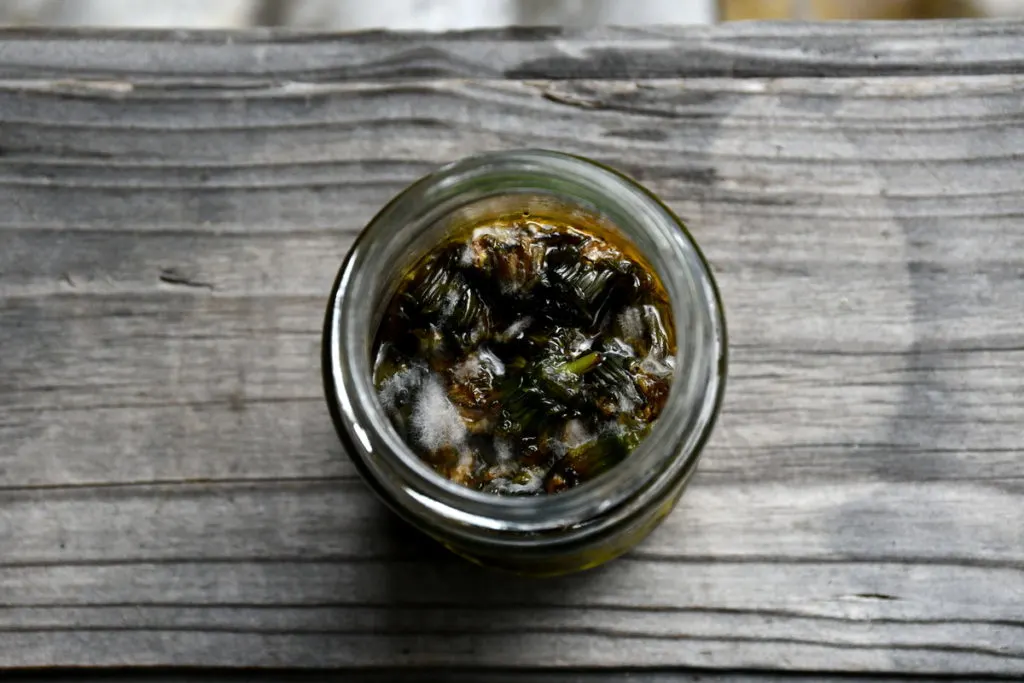
As soon as you notice that something is “off”, remove it immediately with a small spoon and strain as soon as possible.
If the mold is throughout, toss it on the compost and start over.
When two weeks of steeping are over…
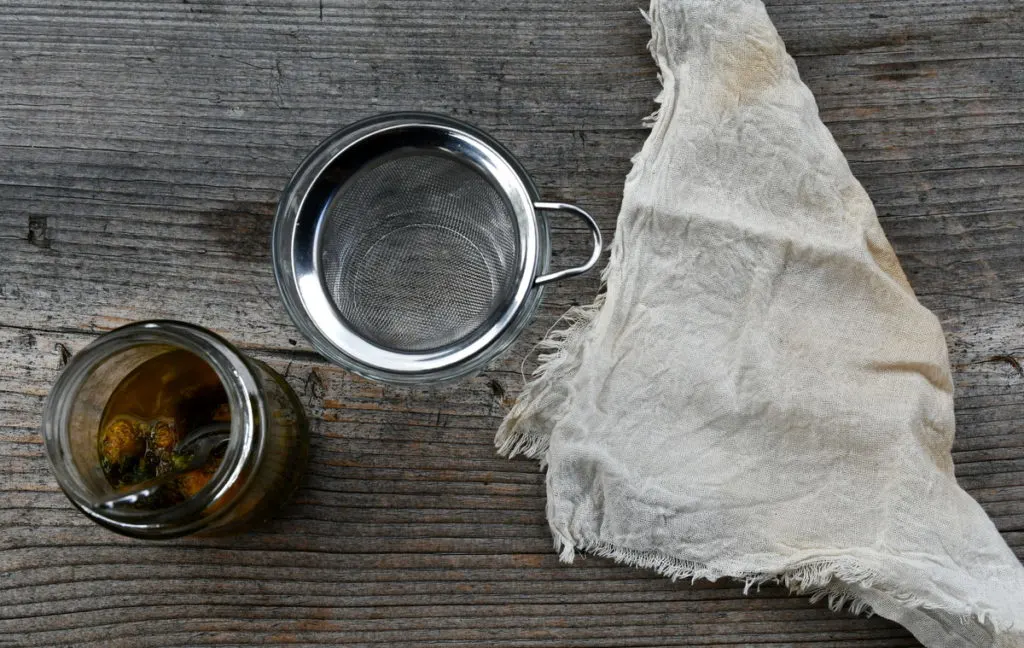
At this point, your dandelion infused oil is ready for straining.
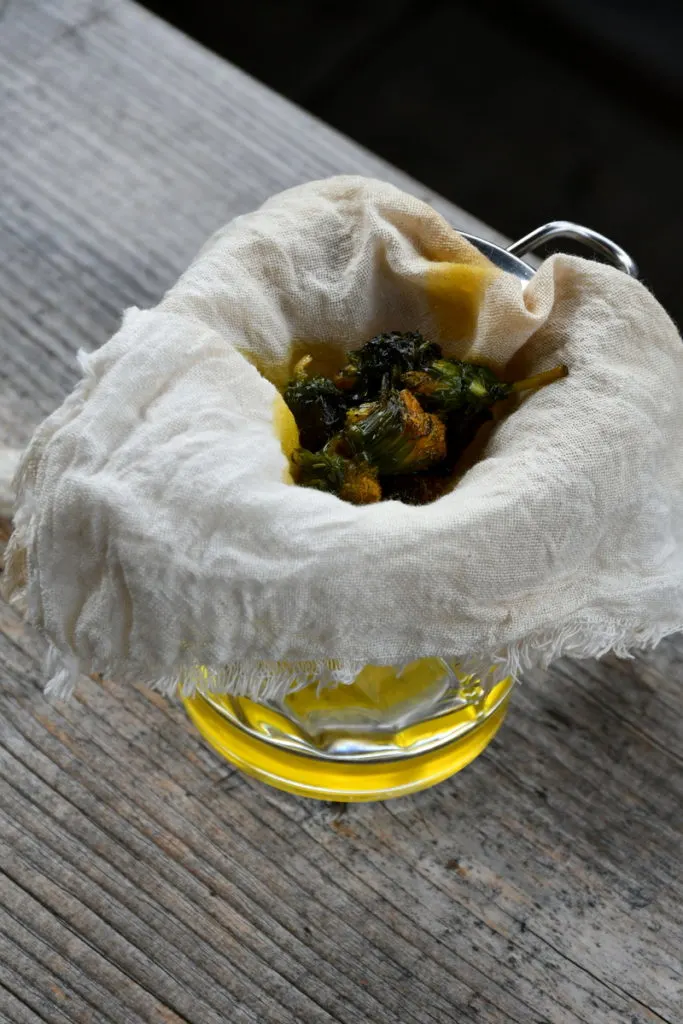
With a double layer of cheesecloth over a clean small bowl (or jar), let it drip as long as it takes. Then squeeze out every remaining drop of oil. It’s valuable stuff.
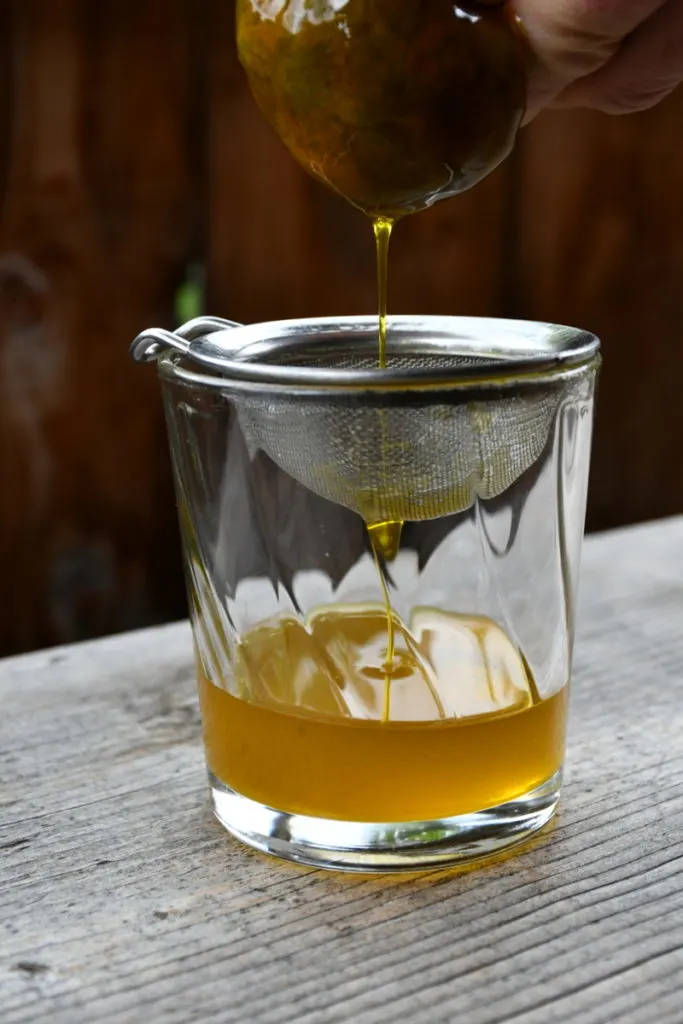
You’ll be thankful that you did.
Store your dandelion infused oil in a sterile glass bottle in a cool, dark place. Be sure to add a label stating not only what is inside, but with the date of creation too.
Make sure to use up the oil within one year as all oils will go rancid after a time.
Don’t worry about lack and it not being enough. You can always count on dandelions coming up next year by the leaps and bounds. Then you can make more or less, depending on your needs.
How to use your dandelion infused oil
Dandelion oil is not meant to be ingested, rather applied to your skin.
If you’d rather eat or drink the benefits of dandelion, stick to dandelion jelly, dandelion mead or dandelion fritters. Don’t forget you can also eat them fresh, simmer them in teas or roast the dandelion roots for a coffee substitute.
Isn’t it incredible how versatile dandelions are?
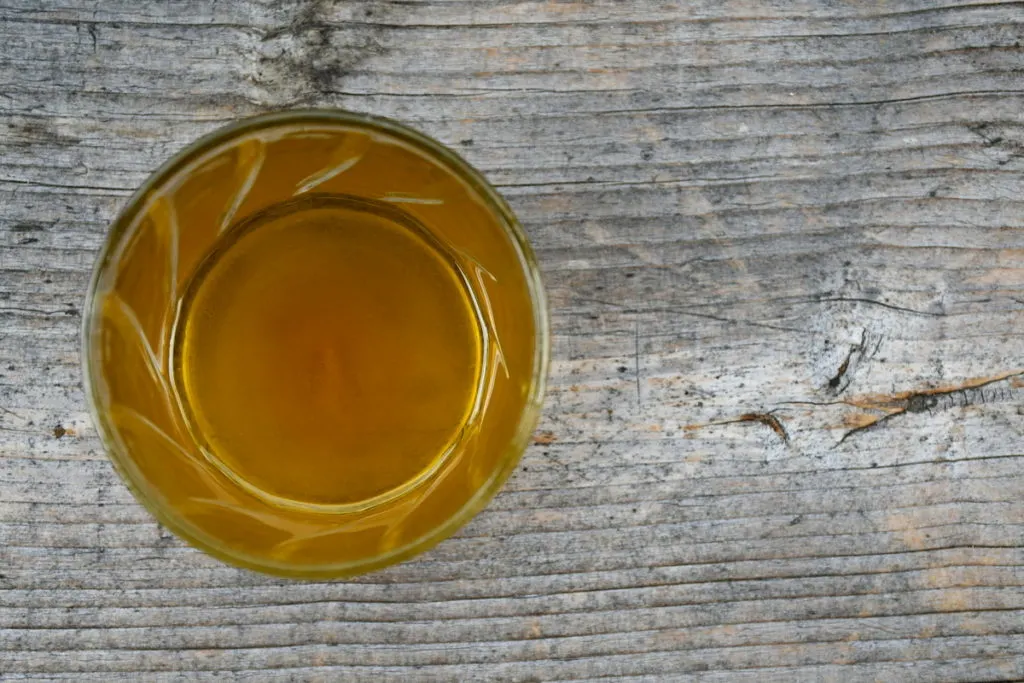
But how exactly to use your dandelion infused oil? Here are 6 ways for you to use it up, much to the delight of your skin.
6 ways to use your dandelion oil
1. Dandelion salve
Herbal salves can easily be made at home when you are prepared with the right ingredients. Obviously, in the case of dandelion salve, you are going to need a dandelion infused oil.
Dandelion salves are wonderful for moisturizing dry and cracked skin, both on your hands and on your feet. If you like to garden without gloves, you won’t want to miss out on making this one.
It gets bonus points for acting as a lip balm too.
2. Dandelion infused oil in your herbal first aid kit
From cuts, scrapes and sunburns to the bug bites of summer, dandelion oil can come to your aid quickly. Just be sure to never apply it to an open wound.
3. Dandelion oil for diaper rash
My time to test this one is long gone, so I don’t have firsthand experience on the matter. Back in the day of cloth diapering our daughter, we used slippery elm powder for those small handful of times when there was ever a problem.
However, if you are looking to eco-ize your baby care routine, you might want to try out some dandelion infused oil (either as a direct oil or a salve) as you eliminate potentially harmful chemicals from your life.
4. Dandelion massage oil
An Epsom salt foot bath can certainly help you to relax at the end of a long day.
A reflexology foot massage with dandelion oil takes that relaxation another step further. If your soles are tired from standing and walking all day, massage the dandelion oil straight into your feet.
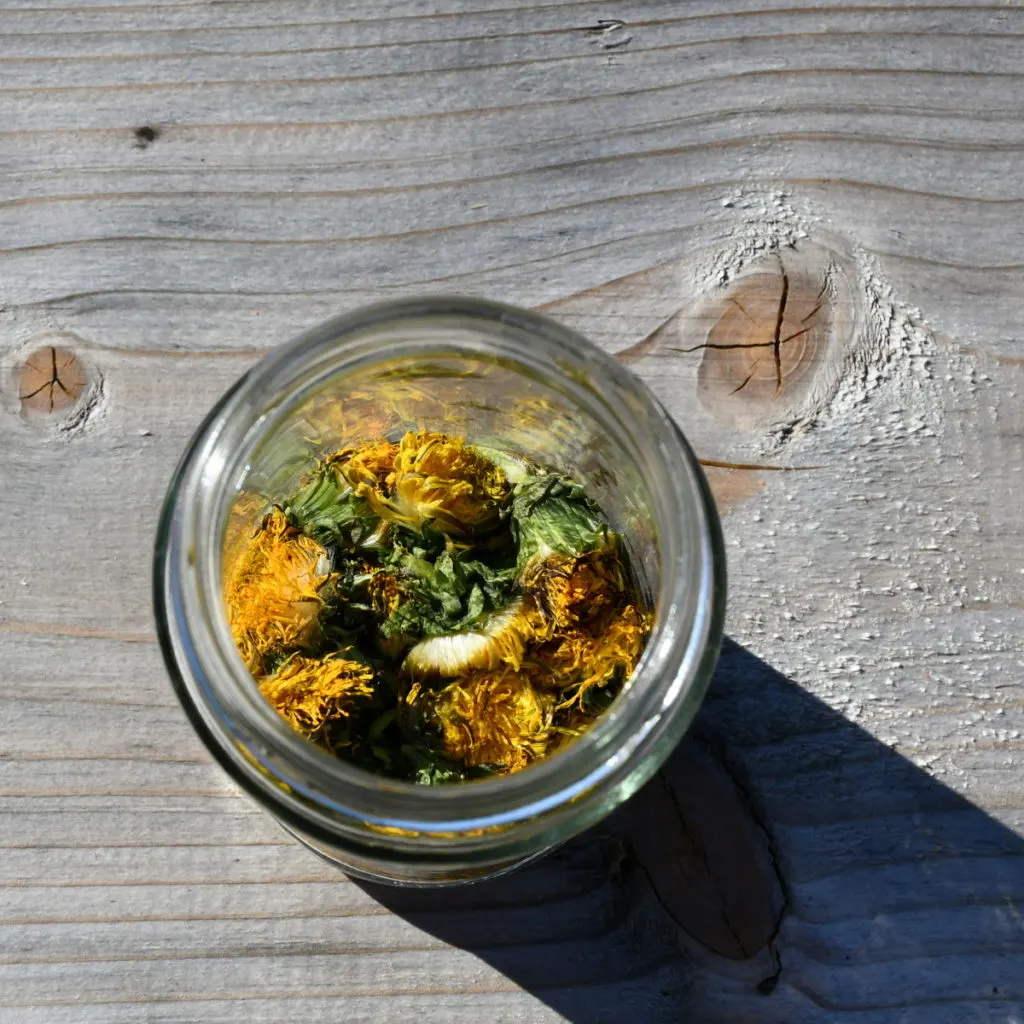
5. Hand lotion
If you’ve got hard working hands, a little self-care may be in order.
Also, if you’ve been washing your hands a lot, or a little more than normal, your skin may feel dry and/or cracked.
Whip up a magic potion of dandelion-infused hand lotion and you’ll be back to business in no time at all.
6. Lotion bars
If you’ve never tried a lotion bar, or never made one yourself, there is a first time for everything. And the first time is now.
Once your batch of dandelion infused oil is ready, this is the dandelion lotion bar potion to make.
All it takes is beeswax, shea butter and dandelion infused oil.
As you can see, my dandelion infused oil is ready. So, I’m off to make some lotion bars because the gardening season has only just begun.
Wishing you a bountiful dandelion harvest!

Get the famous Rural Sprout newsletter delivered to your inbox.
Including Sunday musings from our editor, Tracey, as well as “What’s Up Wednesday” our roundup of what’s in season and new article updates and alerts.

